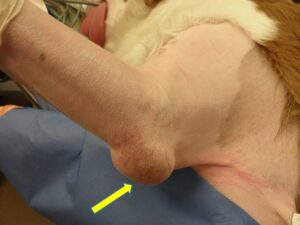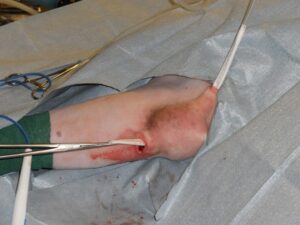-
Adopt
-
Veterinary Care
Services
Client Information
- What to Expect – Angell Boston
- Client Rights and Responsibilities
- Payments / Financial Assistance
- Pharmacy
- Client Policies
- Our Doctors
- Grief Support / Counseling
- Directions and Parking
- Helpful “How-to” Pet Care
Online Payments
Emergency: Boston
Emergency: Waltham
Poison Control Hotline
-
Programs & Resources
- Careers
-
Donate Now
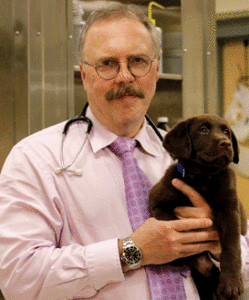 By Michael M. Pavletic DVM, DACVS
By Michael M. Pavletic DVM, DACVS
Director of Surgical Services
Angell Animal Medical Center
angell.org/surgery
617-541-5048
Overview: Closed Suction (Vacuum) Drainage Systems
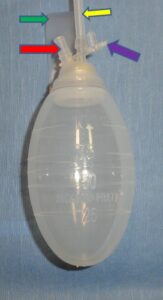
Figure 1: 100cc Jackson-Pratt Drain Reservoir, with attached drain tubing (yellow arrow). The drain spout (red arrow) is opened by removing the attached plug (purple arrow). After removal of the plug, the volume of fluid is recorded using the milliliter (cc) scale marking on the reservoir. The fluid is emptied, the air squeezed from the reservoir, and the plug inserted to restore the vacuum.
Closed suction drainage devices are active drain systems that operate on the principle of creating a vacuum in a chamber that draws fluid from the body area through a fenestrated drain placed beneath the skin. Most chambers are collapsible plastic canisters containing a spring or expansile mechanism that pushes the reservoir walls outward, to create a vacuum. The better constructed devices have a dual “Y” port for the potential placement of two drains: an internal one-way (anti-reflux) valve prevents reflux of fluid from the chamber back to the wound. Markings on the canister allow the surgeon to determine the amount of fluid accumulated. A spout permits emptying of fluid accumulated in the vacuum chamber and the reservoir is collapsed and sealed with the attached plug to re-institute this active drainage system (Figure 1).
There are several vacuum drain designs in use in human surgery. One of the most economical systems used in veterinary medicine is the Jackson-Pratt (J-P) drain system, comprised of a fenestrated wound drain that connects to a silicone reservoir: the elastic walls create a vacuum chamber when activated. A 100ml J-P reservoir is ideal for most small animal surgical procedures (Figure 1). They have the potential to be cleaned and re-sterilized in the autoclave for reuse. The best fenestrated drains are composed of silicone with multiple holes or recessed grooves to minimize obstruction from blood clots and tissue debris (Figure 2). They enter the surgical space through a small stab wound created in the adjacent skin. A purse-string skin suture is used to prevent air from leaking at the stab incision, into the surgical site. The ends of the purse-string suture are looped around the drain and tied to prevent displacement of the drain using a “finger-trap knot”. Redundant external tubing is removed with scissors before attaching the end of the tube onto the entry port of the vacuum canister. Closed suction units can be used for several days with minimal risk of ascending infection. Owners record the daily fluid volume in the reservoir: this will help determine the optimal time to eventually remove the drain system. An Elizabethan collar is advisable to prevent disturbance of the drain system by the patient.
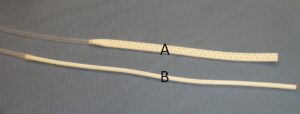
Figure 2A: Examples of the 10mm wide flat drain (A) and 15Fr Jackson-Pratt Hemaduct round drain (B).
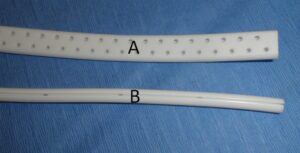
Figure 2B: Close-up view of the 10mm wide flat drain (A), used for elbow hygroma management and the 15Fr round Jackson-Pratt drain (B) used in the management of large aural hematomas. This latter drain has four recessed channels for collecting fluid, ideal for the management of aural hematomas.
Vacuum drainage systems are remarkably effective in removing fluid from large dead-space areas and deep pocket wounds postoperatively. Unlike Penrose drains (discussed below) the vacuum allows for drainage independent of gravity. Moreover, the vacuum effect draws adjacent tissues together, permitting fibrous connective tissue to link apposed tissue planes. Surgical hemostasis within the drain pocket is important since blood clots can obstruct the drain fenestrations. Additionally, air entering the wound will cause the canister to inflate, inactivating the vacuum required to remove fluid. In this situation, a few additional sutures or skin staples can be used to seal a gap in the incision. A thick layer of ointment applied along the incision can prevent air leakage until a fibrin seal forms along the incision within several hours after surgery. Alternatively, surgical cyanoacrylate glue can be used to seal a problematic area.
Overview: Penrose Drains
The simplest and most economical of the passive drains employed in small animal surgery is the Penrose drain, a soft tubular strip of radiopaque latex that is sold in various widths. Penrose drains allow for the passage of fluids by capillary action over the outer surface of the drain. Fluid then gravitates downward and out of the dependently placed (lower) exit incision. The more proximal portion of the drain is secured to the skin with a trans-cutaneous skin suture; the exit (lower/dependent) end of the drain is sutured to the stab incision.
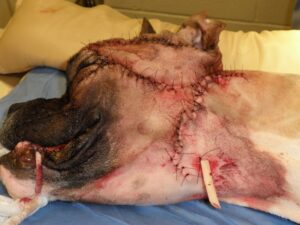
Figure 3: Facial reconstruction after major loss of skin overlying the left facial area (secondary to a skunk bite). Note the ¼ inch Penrose drain used to control the surgical dead-space created by elevation of the lower facial/cervical skin and transfer of a transposition flap from the lateral cervical area
Penrose drains are adequate for the drainage of smaller dead-space areas, but are less than ideal for larger areas, especially when prolonged drainage is anticipated (Figure 3). Penrose drains function poorly in body areas where gravitational drainage cannot be provided. Penrose drains are normally retained for 3 to 5 days depending upon the volume of fluid exiting the area. They can be removed as early as 48 hours after insertion if drainage is minimal. The longer the drain is retained, the greater the likelihood of ascending infection from contamination at the drain exit. When possible, a Penrose drain should be covered with a topical antimicrobial agent and a sterile dressing, although this is not easily accomplished in some body regions. Because drainage at the exit site often drip onto the adjacent skin, local skin irritation is possible, especially with their prolonged use. If the Penrose drain is left exposed, it is advisable to gently cleanse the exit area with sterile saline (with the addition of povidone iodine or chlorhexidene) followed by a topical antimicrobial agent, two or three times daily. Additionally, an Elizabethan collar is advisable to prevent the patient from chewing or removing the drain. If the patient removes a portion of the drain, radiographs may be necessary to assure that no drain fragment is retained in the body (Penrose drains are radiopaque). Retained portions of a Penrose drain will elicit a foreign body reaction and promote infection (draining tracts) until its removal.
It is important to remember that air can enter the body through the exit end of the Penrose drain: they are best avoided for thoracic wounds in which pneumothorax may occur through a chest wall opening. Penrose drains employed in the flank area in particular can result in a “sucking wound;” as the patient walks, air may be pulled into dead space by the vacuum formed, resulting in subcutaneous emphysema.
Vacuum Drains Versus Penrose Drains
Vacuum drains have multiple advantages over the use of Penrose drains in small animal surgery, including:
- Draining surgical areas without the need for their dependent placement (they do not depend on gravity)
- Containing the fluid collected and allowing its visual assessment
- Quantifying the volume of fluid collected on a daily basis to help determine the optimal time to remove the drain
- Ideally suited for large dead space areas and problematic areas
- They do not allow air to enter the wound cavity, a potentially serious issue when used for traumatic thoracic wall wounds secondary to trauma
- Low risk of ascending infection even with long term usage
- Simple to insert, economical to use
- Can be re-sterilized for additional use, if so desired
- Easy for owners to maintain at home
- Minimal nursing care
- Potentially reusable (autoclave sterilization) silicone drain tubing and reservoir
By contrast, Penrose drains have the following advantages over the use of vacuum drain systems.
- Very inexpensive
- May be more suitable for small tissue pockets requiring drainage
- Wounds in which drainage is required for only a few days
- Unlike vacuum drains, air entering the surgical space will not inactivate Penrose drain function
New Uses for Vacuum Drain Systems
More recently, the author has used vacuum drains for two special conditions in dogs:
- Elbow Hygromas
- Aural Hematomas
These two techniques have recently been published in the Journal of Small Animal Practice and the Journal of the American Veterinary Medical Association (see references). Each of these uses will be discussed separately.
Elbow Hygromas
Elbow hygromas are the result of prolonged or repeated compressive trauma of the skin and subcutaneous tissues overlying the olecranon. This is usually the result of large, heavy dogs reclining on hard surfaces. It is my experience that elbow hygromas are relatively uncommon today, compared to the number of cases noted in the 1970s and 1980s. This could be the result of changes in the popularity of giant breed dogs or regional breed variations. It may also involve a positive change in the “lifestyle” of giant breed dogs including soft bedding provided for the pet to recline on in the home. Better informed owners of large breed dogs are aware of the risk of elbow hygromas and understand that padded protection of the olecranon area is critical to preventing their formation.
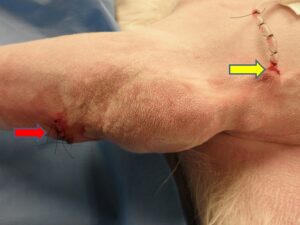
Figure 4C: Postoperative view of the hygroma. Note the non-fenestrated portion of the Jackson-Pratt Hemaduct drain exiting dorsal to the hygroma. The drain is secured to the skin with a purse-string knot and finger trap knot (yellow arrow). Note the lower access incision closed with interrupted skin sutures (red arrow).
Most large hygromas require prolonged drainage to resolve. Penrose drains (often used over a three week period) have been used effectively to resolve hygromas. Unfortunately this technique requires the prolonged maintenance of a heavily padded, compressive bandage that requires periodic changes as fluid accumulates into the absorbent cotton (secondary bandage layer). It is also difficult to maintain the bandage in its proper position as the materials slowly stretch and loosen secondary to the motion of the patient.
Recently, I reported on a simpler method using a vacuum drain to resolve a large hygroma in a St. Bernard (Figure 4). A vacuum drain system was inserted into the hygroma pocket and maintained over a three week period without the need for a protective bandage. Soft bedding was provided to the patient to help prevent its recurrence after drain removal. This simple and more economical surgical technique resolved this patient’s large hygroma when followed over an 18 month period.
Aural Hematomas
There are a variety of techniques used to manage aural hematomas in dogs, most of which involve some form of drainage. From my experience, the most effective surgical drainage technique for large aural hematomas, with a low incidence of recurrence, was incisional drainage over the medial (concave) surface of the pinna. Other techniques using passive drainage (Penrose drain, teat cannulas, etc) have variable results. The use of Vacutainer Tubes (glass vacuum tubes) and modified butterfly catheters has been reported but their use also can be problematic. With few exceptions, these drainage techniques require the use of a protective bandage during the healing process. During the course of management, the bandages frequently require positional adjustment and periodic changes depending on the amount of drainage present.
Scarring and deformation of the pinna is most notable in chronic aural hematomas. Incisional drainage also contributes significantly to scarring/ wrinkling of the pinna. There is pain associated with incisional drainage/suturing: analgesics are important to keeping the patient comfortable postoperatively. [Deformity of the ear can be potentially minimized by early drainage intervention and minimal surgical trauma, as noted in this study.]
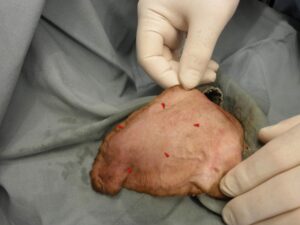
Figure 5A: Aural Hematoma, Vizsla. Arrows denote the magnitude of the hematoma pocket within the delaminated pinnal cartilage.
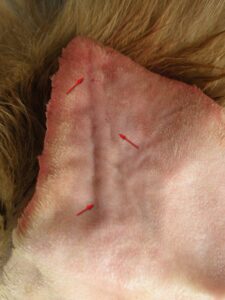
Figure 5B: Note the silhouette of the Jackson-Pratt Hemaduct drain (arrows) after insertion and activation of the vacuum reservoir.
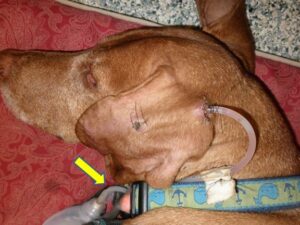
Figure 5C: Patient prior to removal of the vacuum drain system, Note the Jackson-Pratt reservoir attached to the patient’s collar (yellow arrow). An Elizabethan collar is used to protect the ear and drain system from patients attempting to scratch at the area.
To date, all approaches to the aural hematoma involve the comparatively hairless, medial (concave) aspect of the pinna. While it may seem counterintuitive to drain hematomas from the lateral (convex) surface of the pinna, it is an ideal location to place a vacuum drain (Figure 5). An Elizabethean collar is used to protect the vacuum drain system during the course of treatment. No bandage is required, but the patient can be checked weekly to assure the vacuum drain system is functioning effectively. Drains are removed in 18-21 days with the skin sutures. In this study, 4 patients had long term resolution of their aural hematoma; the treated ears were comparable cosmetically to the normal ear. One dog had slight wrinkling of the pinna secondary to assymetrical stretching of the delaminated pinnal cartilage. All patients tolerated the vacuum drain system and were comfortable during its use.
Final Comment:
Readers are welcome to contact me if they require any further advice on the use of vacuum drains for aural hematomas, elbow hygromas, or other general uses of this system.
References:
- Pavletic, MM, Brum, D. Successful closed suction drain management of a canine elbow hygroma. J Sm Anim Practice, in press.
- Pavletic MM. Use of laterally placed vacuum drains for management of aural hematomas in five dogs. J Am Vet Med Assoc 2015; 246: 112-117.
